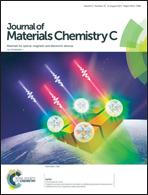Ultrahigh electromagnetic interference shielding performance of lightweight, flexible, and highly conductive copper-clad carbon fiber nonwoven fabrics†
Abstract
Highly conductive carbon-based fibrous materials have become one of the most sought-after components in electromagnetic interference (EMI) shielding due to their well-known properties. Herein, to fabricate exceptional shielding materials which possess desirable specific EMI shielding effectiveness (SSE) and absolute shielding effectiveness (SSEt), lightweight, flexible, pitch-based activated carbon fiber fabrics (ACFs) that bear high surface areas and fitting thicknesses were fabricated as a carbon framework. Moreover, a thin copper layer uniformly clad on the fiber surface, as a highly conductive functional part, was deposited via electroless plating. The EMI shielding performance was studied in both low and high frequency ranges of 30 MHz–1.5 GHz and 1.5–10 GHz, respectively. The fiber-stacked foam architecture provided the assembled fabrics with a high conductivity and multiple internal reflections during shielding that manifested exceptional SSE (up to 482.2 dB cm3 g−1) and SSEt (11 162 dB cm2 g−1) values, which were far better than those of the pure ACFs and void-free Cu foil. Moreover, the fabrics also showed excellent pitting resistance. The prepared shielding materials can be applied to many practical and commercial applications.



 Please wait while we load your content...
Please wait while we load your content...